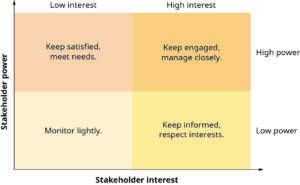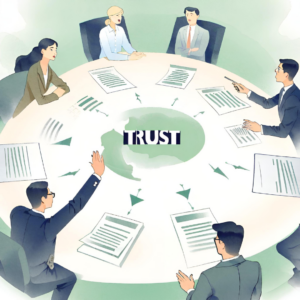Chapter 2: Fair

The following chapter discusses one of the foundational principles in ethics – fairness. Fairness is one of the “fundamental pillars” in ethical models (Tubella et al., 2022). Fairness is a complex component in terms of ethics, so let’s start by breaking down the definition and then move on to timing and approaches related to ethics.
Below are some research supported definitions of fairness. Which one aligns with what you know about ethics? Do all of these define it properly? How could they be improved?
- Fairness is bias mitigation (Tubella et al., 2022).
- Fairness is when the outcomes, performance, and effects of a project does not produce discrimination (Giovanola & Tiribelli, 2023).
- Fairness includes fair pricing, environments, networking, short chain, and working conditions (Del Prete & Samoggia, 2023).
- Fairness is the absence of bias (Giovanola & Tiribelli, 2023).
Tubella et al. (2022) clarify fairness as a situation which requires specific conditions met in order be declared “fair”. How to define fairness within an organization is going to vary as well as when to enforce the definition. How and when a “fairness intervention” is introduced in a system can not only “affect who benefits”, but also who is “excluded from the positive impact” (Tubella et al., 2022).
The How
 How fairness is determined is based on how an organization detects and measures an undesired amount of bias, which can often lead to discrimination. Concessions may need to be made in one area in order to be more fair to all areas. How fairness is defined will also likely be affected by the specific societal norms and expectations. Considerations should be made regarding individual fairness (preventing harm to an individual) and group fairness (preventing harm to specific group, such as women vs. men) (Tubella et al., 2022).
How fairness is determined is based on how an organization detects and measures an undesired amount of bias, which can often lead to discrimination. Concessions may need to be made in one area in order to be more fair to all areas. How fairness is defined will also likely be affected by the specific societal norms and expectations. Considerations should be made regarding individual fairness (preventing harm to an individual) and group fairness (preventing harm to specific group, such as women vs. men) (Tubella et al., 2022).
The When
 There are two different approaches to establishing fairness, these are “in-processing” and “post-processing”. Generalizing the ideas of Tubella et al. (2022) to a larger context, in-processing means before the project or other initiative begins, the organization looks at how they can build the project fairly. They begin with data to determine who they would be serving, who would benefit the most from services, and so on. Post-processing, again generalized, means after a project as begun, an organization retroactively evaluates it for fairness. Adjustments to the project may need to be made in order to fit the current definition of fairness, outlined by the organization. Here are some examples, to help visualize these concepts.
There are two different approaches to establishing fairness, these are “in-processing” and “post-processing”. Generalizing the ideas of Tubella et al. (2022) to a larger context, in-processing means before the project or other initiative begins, the organization looks at how they can build the project fairly. They begin with data to determine who they would be serving, who would benefit the most from services, and so on. Post-processing, again generalized, means after a project as begun, an organization retroactively evaluates it for fairness. Adjustments to the project may need to be made in order to fit the current definition of fairness, outlined by the organization. Here are some examples, to help visualize these concepts.
- A new outreach campaign is preparing to be launched from a local healthcare provider. They want to be fair in their representation and marketing. They anticipate being fair by representing all local demographics in their marketing materials, ordering the opportunities in alphabetical order so one service is not highlighted over another, and by conducting their outreach digitally (emails), on social media, mail, and at-person events in order to attract all demographics, regardless of access to any one specific media source.
- Do you think this version of in-processing is fair?
- An educational program has been running in the local parks system for several years, but as the program has grown and evolved over time, it needs to be updated in order to be better aligned with diversity, equity, inclusion, and belonging principles. After the most recent season, the entire program was reviewed by staff and also had external reviewers to find opportunities to update the program for more fair representation of the local culture and its people.
- Do you think this version of post-processing is fair?
Why is fairness important?

Fairness is critical in the distribution of products and services; it is integral in the workplace, encouraging more motivation and loyalty within an organization. When implementing appropriately, it has the ability to create a positive work climate and increase job satisfaction. Wang and Ahoto (2022) discovered in their study supervisory fairness influence job satisfaction, work climate, task performance, and helping behavior. Basically, where there is fairness there is also more commitment to the job.
The same is true for other elements in the workplace. Fairness should be applied to projects, schedules, and duties.
Identifying Stakeholders Fairly
(Remixed from Ethical Decision Making and Prioritizing Stakeholders, by Rice University)
If we carry the idea of stakeholder to the extreme, every person is a stakeholder of every company. The first step in stakeholder management, the process of accurately assessing stakeholder claims so an organization can manage them effectively, is therefore to define and prioritize stakeholders significant to the firm. Then, it must consider their claims.
Given that there are numerous types of stakeholders, how do managers balance these claims? Ethically, no group should be treated better than another, and managers should respond to as many stakeholders as possible. However, time and resource limitations require organizations to prioritize claims as stakeholder needs rise and fall.
Step 1: Prioritization
First, it may help to speak to the expectations that any stakeholders may have of a particular business or institution. It depends on particular stakeholders, of course, but we can safely say that all stakeholders expect a form of satisfaction from an organization. If these stakeholders are shareholders (stockowners), then they generally wish to see a high return on their purchase of company shares. If, on the other hand, they are employees, they typically hope for interesting tasks, a safe work environment, job security, and rewarding pay and benefits. If, yet again, the stakeholders are members of the community surrounding a business, they usually wish that the company not harm the physical environment or degrade the quality of life within it.
After establishing that a key stakeholder group is being represented, the manager should identify what the company needs from the stakeholder. This simply helps clarify the relationship. If nothing is needed immediately or for the foreseeable future, this does not mean the stakeholder group does not matter, but it can be a good indication that the stakeholder need not be prioritized at the moment. What matters is establishing that someone is a stakeholder, that the concern is currently important, and that the relationship matters for the growth of the business.

Stakeholder prioritization will also vary based on time and circumstance. For example, a large retailer facing aggressive new competitors must prioritize customer service and value. With Amazon acquiring Whole Foods and drastically cutting prices, the grocery chain’s customer base may very well grow because prices could become more attractive while the perception of high quality may persist. Potential customers may no longer need to economize by shopping elsewhere. Whole Foods’ competitors, on the other hand, must now prioritize customer service, whereas before they could compete on price alone. Whole Foods can become a serious competitor to discount grocery stores like ALDI and Walmart.
Another way to prioritize stakeholder relationships is with a matrix of their power and interest. As the figure below shows, a stakeholder group can be weighted on the basis of its influence (or power) over and interest in its relationship to the firm. A stakeholder with a high level of both power and interest is a key stakeholder. If this type of stakeholder group encounters a problem, its priority rises.

Step 2: Managing Expectations
Stakeholder management does not work if the firm’s prioritizing decisions are based on flawed, inaccurate, or incomplete information. Some tools are available to help. MITRE is a nonprofit research and development consulting firm that helps governments and other large organizations with many stakeholders conduct stakeholder assessment. The MITRE Guide to Stakeholder Assessment and Management lays out a five-step system for stakeholder management.
 Overall, MITRE stresses that an organization must sustain trust with its stakeholders through communication efforts. To accomplish this, however, stakeholders must first be clearly identified and then periodically reidentified, because stakeholder cohorts change in size and significance over time. The concerns or claims of stakeholders are identified through data gathering and analysis. Sometimes a firm will conduct surveys or focus groups with customers, suppliers, or other stakeholders. Other times, product usage data will be available as a function of sales figures and marketing data. For software in web and mobile applications, for example, user data may be readily available to show how stakeholders are using the company’s digital services or why they appear to be purchasing its products. Another source of stakeholder data is social media, where firms can monitor topics stakeholders of all types are talking about. What matters is gathering relevant and accurate data and ensuring that key stakeholders are providing it. In the next step, managers present the results of their research to the company’s decision makers or make decisions themselves.
Overall, MITRE stresses that an organization must sustain trust with its stakeholders through communication efforts. To accomplish this, however, stakeholders must first be clearly identified and then periodically reidentified, because stakeholder cohorts change in size and significance over time. The concerns or claims of stakeholders are identified through data gathering and analysis. Sometimes a firm will conduct surveys or focus groups with customers, suppliers, or other stakeholders. Other times, product usage data will be available as a function of sales figures and marketing data. For software in web and mobile applications, for example, user data may be readily available to show how stakeholders are using the company’s digital services or why they appear to be purchasing its products. Another source of stakeholder data is social media, where firms can monitor topics stakeholders of all types are talking about. What matters is gathering relevant and accurate data and ensuring that key stakeholders are providing it. In the next step, managers present the results of their research to the company’s decision makers or make decisions themselves.
Finally, stakeholders should be informed that their concerns were taken into consideration and that the company will continue to heed them. In other words, the firm should convey to them that they are important.
Step 3: Making a Decision
Determine your final list of stakeholders by considering the answers to each of these questions, if they don’t meet all of the required criteria, then they may not be a priority stakeholder. You want to be fair, but also strategic as no organization can reasonably provide individualized treatment to every stakeholder, every time (Kenny, 2014).
- Does the stakeholder have a fundamental impact on your organization’s performance? (Required response: Yes)
- Can you clearly identify what you want from the stakeholder? (Required response: Yes)
- Is the relationship dynamic and do you want it to grow? (Required response: Yes)
- Can you exist without or easily replace the stakeholder? (Required response: No)
- Has the stakeholder already been identified through another relationship? (Required response: No)
Check Yourself
Additional Resources
- Moral judgments of Fairness-related actions are flexibly updated to account for contextual information (Andrejevic et al., 2020)
- Perceived workplace fairness, ethical leadership, demographics, and ethical behaviors (Adekanmbi & Ukpere, 2022)
References
Baumann, J., & Loi, M. (2023). Fairness and risk: An ethical argument for a group fairness definition insurers can use. Philosophy & Technology, 36(45). https://doi.org/10.1007/s13347-023-00624-9
Del Prete, M., & Samoggia, A. (2023). Does fairness matter? Consumers’ perception of fairness in the agro-food chain. Frontiers in Sustainable Food Systems, 7. https://doi.org/10.3389/fsufs.2023.116319/full
Giovanola, B., & Tiribelli, S. (2023). Beyond bias and discrimination: Redefining the AI ethics principle of fairness in healthcare machine-learning algorithms. MAIEI. Retrieved on October 6, 2023 from https://montrealethics.ai/beyond-bias-and-discrimination-redefining-the-ai-ethics-principle-of-fairness-in-healthcare-machine-learning-algorithms/
Kenny, G. (2014). Five questions to identify key stakeholders. Harvard Business Review. https://ecampusontario.pressbooks.pub/businessethicsopenstax/chapter/ethical-decision-making-and-prioritizing-stakeholders/
Rice University (2018). Business ethics. Retrieved on October 6, 2023 from https://ecampusontario.pressbooks.pub/businessethicsopenstax/chapter/ethical-decision-making-and-prioritizing-stakeholders/
Tubella, A., Barsotti, F., Kocer, R., & Mendez, J. (2022). Ethical implications of fairness interventions: What might be hidden behind engineering choices. Ethics and Information Technology, 24(12). https://doi.org/10.1007/s10676-022-09636-z
Wang, W., & Ahoto, A. (2022). Influence of supervisors’ fairness on work climate, job satisfaction, task performance, and helping behavior of health workers during COVID-19 outbreak. Frontiers in Psychology, 13. https://doi.org/fpsyg.2022.822265

